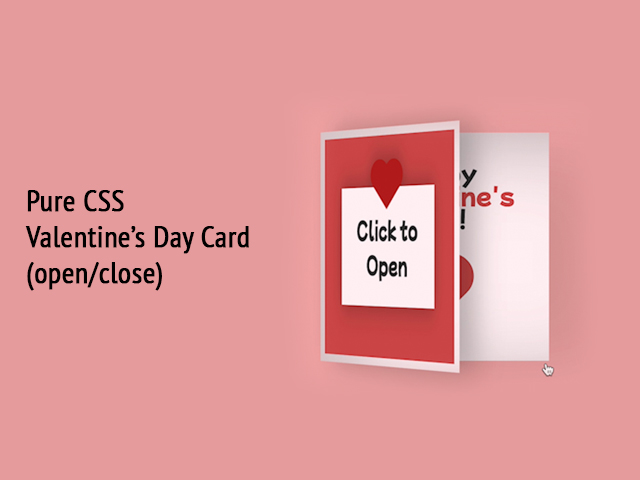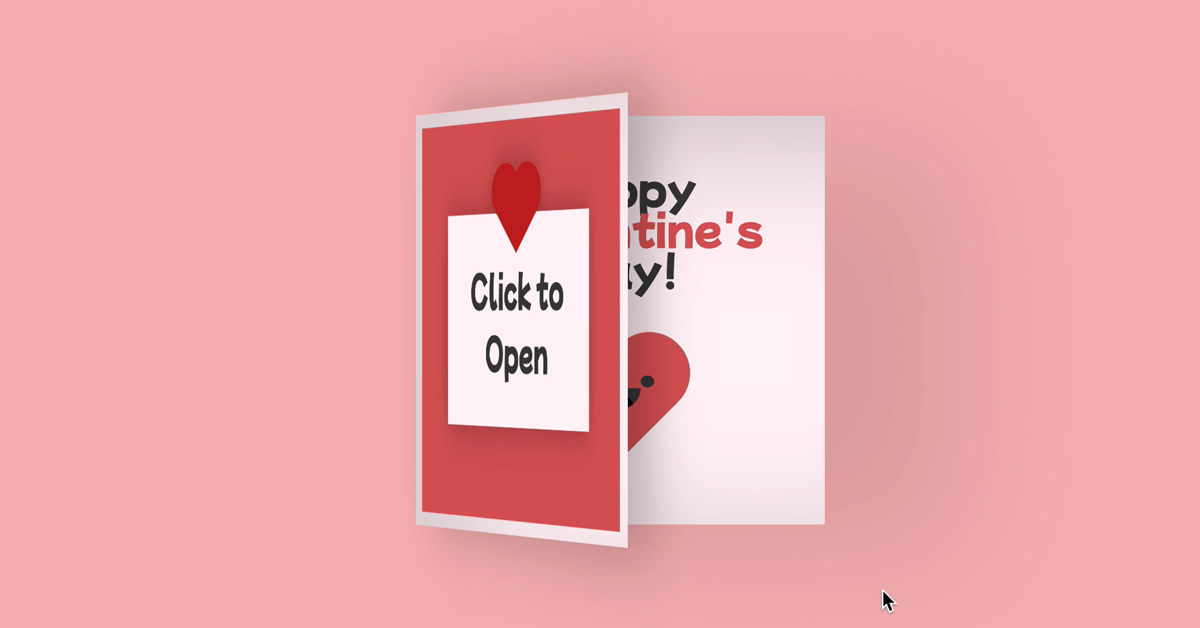
To learn how to create the CSS Valentine’s Day Card (Open/Close on Click) follow the steps below and watch the video tutorial.
Demo:
Step1.
Add HTML
<div class="valentines-day-card">
<input id="open" type="checkbox">
<label class="open" for="open"></label>
<div class="card-front">
<div class="note">Click to Open</div>
</div>
<div class="card-inside">
<div class="text-one">Happy
</div>
<div class="heart"></div>
<div class="smile"></div>
<div class="eyes"></div>
</div>
</div>Step2.
Add CSS
Import the font:
Font source: Google Fonts
To read how to import the font in CSS click here.
@import url('https://fonts.googleapis.com/css2?family=Mochiy+Pop+P+One&display=swap');Set the colour and the position of the background and the elements:
body {
height: 100vh;
display: flex;
justify-content: center;
align-items: center;
background-color: #f2acac;
font-family: 'Mochiy Pop P One', sans-serif;
}Style the card (make the card open/ close):
input#open {
display: none;
}
.valentines-day-card {
position: relative;
width: 300px;
height:300px;
transform-style: preserve-3d;
transform: perspective(2500px);
transition: .3s;
}
.card-front {
position: relative;
background-color: #fff0f3;
width: 300px;
height:300px;
transform-origin: left;
box-shadow: inset 100px 20px 100px rgba(0,0,0,.15), 30px 0 50px rgba(0,0,0,0.3);
transition: .3s;
}
.card-front:before {
content:"";
position: absolute;
width: 280px;
height: 280px;
background-color: #d04e4e;
top: 10px;
left: 10px;
}
.card-inside {
position: absolute;
background-color: #fff0f3;
width: 300px;
height:300px;
z-index:-1;
left:0;
top:0;
box-shadow: inset 100px 20px 100px rgba(0,0,0,0.22), 100px 20px 100px rgba(0,0,0,0.1);
}
.open {
position: absolute;
width: 300px;
height:300px;
left:0;
top:0;
background-color: transparent;
z-index:6;
cursor: pointer;
}
#open:checked ~ .card-front {
transform: rotateY(-155deg);
box-shadow: inset 100px 20px 100px rgba(0,0,0,.13), 30px 0 50px rgba(0,0,0,0.1);
}
#open:checked ~ .card-front:before {
z-index:5;
background-color: #fff0f3;
width:300px;
height:300px;
top:0;
left:0;
box-shadow: inset 100px 20px 100px rgba(0,0,0,.1), 30px 0 50px rgba(0,0,0,0.1);
}
Style the front side of the card:
.note {
position: relative;
width: 200px;
height: 150px;
background-color: #fff0f3;
top:75px;
left:50px;
color: #333;
font-size:30px;
display: flex;
align-items: center;
text-align: center;
filter: drop-shadow(0 0 20px rgba(0,0,0,0.3));
}
.note:before, .note:after {
position: absolute;
content:"";
background-color: #ba1c1c;
width: 40px;
height:40px;
}
.note:before {
transform: rotate(-45deg);
top:-20px;
left:80px;
}
.note:after {
border-radius:50%;
top:-35px;
left:65px;
box-shadow:30px 0 #ba1c1c;
}
Style and animate the card inside:
.text-one {
position: absolute;
color: #333;
font-size: 30px;
top:30px;
width:300px;
text-align: center;
}
.text-one:before, .text-one:after {
position: absolute;
left:5px;
text-align: center;
width:300px;
}
.text-one:before {
content:"Valentine's";
top:30px;
color: #d04e4e;
}
.text-one:after {
content:"day!";
top:60px;
}
.heart {
position: relative;
background-color: #d04e4e;
height: 60px;
width:60px;
top:180px;
left:120px;
transform: rotate(-45deg);
animation: .8s beat infinite;
}
.heart:before, .heart:after {
content:"";
background-color: #d04e4e;
border-radius:50%;
height: 60px;
width: 60px;
position: absolute;
}
.heart:before {
top:-30px;
left:0;
}
.heart:after {
left:30px;
top:0;
}
.smile {
position: absolute;
width:30px;
height:15px;
background-color: #333;
z-index:1;
border-radius: 0 0 100px 100px;
top:200px;
left:135px;
overflow: hidden;
}
.smile:before {
content:"";
position: absolute;
border-radius:50%;
width:20px;
height:20px;
background-color: #030202;
top:5px;
left:5px;
}
.eyes {
position: absolute;
border-radius: 50%;
background-color: #333;
width:10px;
height:10px;
z-index:1;
top:190px;
left:165px;
box-shadow: -40px 0 #333;
transform-origin: 50%;
animation: close 2s infinite;
}
@keyframes close {
0%, 100% {
transform: scale(1, .05);
}
5%, 95% {
transform: scale(1, 1);
}
}
@keyframes beat {
0%, 40%, 100% {
transform: scale(1) rotate(-45deg);
}
25%, 60% {
transform: scale(1.1) rotate(-45deg);
}
}
Watch also the video tutorial:
Enjoy coding!
Hey, here’s something that might interest you:





